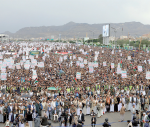You are here
What Northern Ireland teaches us about ending the Ukraine war
Jul 17,2023 - Last updated at Jul 17,2023
NEW YORK — There are many reasons to celebrate the 25th anniversary of the Good Friday Agreement. Reached in 1998, it has provided a political framework that has dramatically reduced violence in a part of the United Kingdom that experienced something very close to civil war for the preceding three decades.
Some of what explains the accord’s success is specific to Northern Ireland. But other factors have broader relevance, providing guidance for approaching conflicts elsewhere, even the war between Russia and Ukraine.
The most fundamental lesson is that diplomacy can succeed only where and when other tools cannot. Successive British prime ministers, Margaret Thatcher, John Major and Tony Blair, created a context that by the late 1990s gave diplomacy a chance. This required two things: First, the UK introduced sufficient security forces so that those in Northern Ireland who sought to shoot their way to power could not succeed. Violence could not be prevented from disrupting lives, but it was not allowed to create political facts.
At the same time, British authorities combined their tough stance against violence with an openness to political dialogue. While no party in Northern Ireland achieved everything it wanted during these negotiations, every faction could realise some of what it sought, and more than any could hope to accomplish through fighting. Getting the protagonists to this point, to where they accepted (no matter how reluctantly) the inevitability of compromise, was essential to move the conflict towards resolution.
In addition, British, Irish and American officials, above all former US Senate Majority Leader George Mitchell, who chaired the negotiations, were modest in what they sought. They did not aim to resolve the entire Northern Ireland problem. To the contrary, they mostly avoided “final status” issues, above all the question of whether Northern Ireland would remain in the UK or one day become part of a united Ireland. The accords went only so far as to establish the ground rules for a process which could lead to a united Ireland. The same willingness to avoid difficult questions of Taiwan’s status and its relationship to China has allowed the United States and China to normalise relations and has helped preserve peace in the Taiwan Strait for a half-century.
This highlights a larger point: Peacemaking must often accept goals less than full peace. Sometimes, aiming for a state of non-belligerence is sufficiently ambitious. Twenty-five years later, Northern Ireland remains divided politically and socially. Yet political violence is largely absent. This is not everything, but it is a lot. Nor is such a situation unique. On both the Korean Peninsula and the island of Cyprus, full peace has never been achieved, but the parties have lived next to each other relatively peacefully for decades.
It is also worth noting that UK, Irish and American diplomats allowed individuals and groups that had authorised or carried out acts of violence to participate in the political process. This was a difficult but necessary concession, as it turned out that those who had demonstrated military strength were the same who had the requisite political strength to make a deal. As then-Israeli Prime Minister Yitzhak Rabin noted, “You don’t make peace with friends. You make it with very unsavory enemies”.
Lastly, authorities kept preconditions, or steps that needed to be taken before negotiations could begin, to a minimum. In Northern Ireland, the principal requirement for participating in the peace process was a cessation of violence. Participants were not asked to give up their arms. This step, known as decommissioning, became one focus of my work years later when I served as US envoy to the dispute.
Each of these lessons may well be relevant for the world’s most dangerous conflict today: The war between Russia and Ukraine. A cessation of hostilities will be possible only if, and when, the parties become convinced that more war will not bring them closer to their goals. This realisation could come as a result of further costly fighting that leads to little change in who controls what territory.
As this happens, possibly later this year, a diplomatic process must be established, possibly modeled on the “two plus four” process that helped end the Cold War. One can imagine here a venue involving only Ukraine and Russia, and a second in which NATO and Russia discuss larger questions of European security.
It is essential that any diplomatic path does not ask the parties to abandon their ultimate goals or give up their arms. Ukraine has every right to insist on the full return of its territory going back to its independence in 1991, while Russian President Vladimir Putin is sure to insist that the Ukrainian territories he has illegally annexed are part of Russia. It may well take decades (and new leadership in Moscow) to resolve these differences. So be it. The immediate goal of a cease-fire should not be contingent on reconciling what cannot be reconciled now or for the foreseeable future.
As distasteful as it might be, those responsible for the war and for war crimes, including Putin, will need to be able to participate directly or indirectly in the diplomatic process if it is to have any chance of success. The top priority now must be to end the violence; the quest for justice ultimately must be pursued, but it should be postponed.
Admittedly, the diplomatic approach to ending the Ukraine war suggested here is far from ideal. But it might just be possible, and it certainly would be better than more of the same. This is the ultimate lesson to be learned from Northern Ireland.
Richard Haass, president of the Council on Foreign Relations, is the author, most recently, of The Bill of Obligations: The Ten Habits of Good Citizens (Penguin Press, 2023). Copyright: Project Syndicate, 2023.












